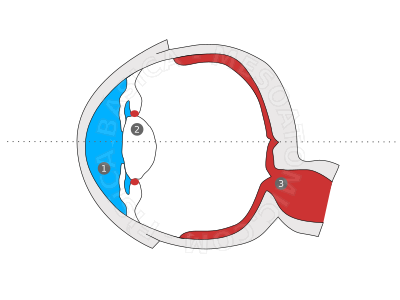- Optics
- /
- Refraction, Lenses and Optical Inst.
- /
- optical instruments
Understanding geometrical optics allows one to build different optical instruments. There are also many optical instruments in nature, but the most important one, for us, is the eye.
Association of Optical Systems
Although most optical instruments are quite complex, we will analyze only the principles of operation. Complex instruments are build from simple associations of lenses, mirrors, prisms etc. When we say that a certain instrument has a "lens" \(L\), the actual instrument will probably have a combination of several lenses, and those lens together exhibit the same behavior of this "resulting lens" called \(L\). The purpose of using a set of lenses is to adapt the input image to a desired output. When associating optical systems, we should know:
- 1: Object and image are relative concepts and depend on the optical system analyzed.
- 2: The image from a 1st system can be used as an "object" for the 2nd system.
Projection Instruments
- Projection instruments should produce a real final image, since the objective is to project images on a screen.
-
-
Instrument Lens Image Camera Convergent Real Slide projector Convergent Real Film Projector Convergent Real
-
Observation Instruments
- Observation instruments generally produce a virtual final image, since these images will be observed directly by the operator having no need to project them on a screen.
-
-
Instrument Lens Image Magnifying glass Convergent Virtual Simple microscope Convergent Virtual Compound microscope Convergent Virtual Astronomical telescope Convergent Virtual
-
Vision Optics

- So it can be studied only from the geometrical optics point of view, we have the "reduced eye", which is a simplified model of the human eye.
- Reduced Eye Elements:
- 1: Diaphragm, which plays the role of the pupil, limiting the width and the inclination of the incident beam to the eye.
- 2: A thin convergent lens which plays the role of the crystalline and whose axis coincides with the optical axis of the eyeball.
- 3: A screen at a fixed distance of 15 mm from the converging thin lens, which acts as a retina. It is located where the images of the displayed objects will be formed.
- Remote Point \(P_{R}\)
- It is the position where an object can be placed so the eyes can generate its image on the retina without accommodation effort.
- Next Point \(P_{N}\)
- It is the position where an object can be placed so the eyes can generate its image on the retina only with a maximum accommodation effort.
Myopia
- Causes
- Elongation of the eyeball or excessive convergence generated by the crystalline.
- Consequences
- The next point is closer than normal (25 cm), the remote point is at a finite distance from the eye, and the image is formed before the retina.
- Correction
- Divergent lenses, whose focus of the correction lens is given by the formula
- \(\frac{1}{P_{R}}=\frac{1}{f}\).
-
Defect Correction Myopia Divergent Lenses Farsightedness Converging Lenses Presbyopia Converging Lenses Astigmatism Cylindrical Lenses Squint Prismatic Lens
